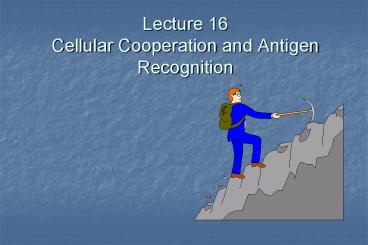Lecture 16 Cellular Cooperation and Antigen Recognition - PowerPoint PPT Presentation
1 / 14
Title:
Lecture 16 Cellular Cooperation and Antigen Recognition
Description:
Lecture 16. Cellular Cooperation and Antigen Recognition ... Cellular Cooperation and Antigen Recognition. APC. Extracellular. Antigen. CD4 Helper T Lymphocyte ... – PowerPoint PPT presentation
Number of Views:149
Avg rating:3.0/5.0
Title: Lecture 16 Cellular Cooperation and Antigen Recognition
1
Lecture 16Cellular Cooperation and Antigen
Recognition
2
Cellular Cooperation
antigen
T
B
H
Plasma Cells
Antigen presentation to T and B cells by APC T
cells elaborate cytokines to facilitate B cell
proliferation and maturation
Antibody secretion by plasma cells
Antigen presenting cell
3
Antigen Presenting Cells
- Must be capable of processing antigen from
extracellular and intracellular pathogens - Must present processed antigen on MHC class I
II molecules - Must express co-stimulatory molecules (cytokines)
4
Types of Professional Antigen Presenting Cells
- Macrophages/monocytes
- Dendritic cells (e.g.., Langerhans cells)
- B cells
5
Properties of Professional Antigen-Presenting
Cells
6
Cellular Cooperation and Antigen Recognition
Class II MHC- associated antigen
APC
Extracellular Antigen
CD4 Helper T Lymphocyte
7
The Role of Adjuvants
- Depot effect
- antigen persists for long period
- resistance to rapid degradation
- Macrophage activation
- production of non-specific enhancing factors
- Non-specific T cell signal
- provides "second" signal to B cell normally
provided by T cell
8
Types of Adjuvants
- Freund's Complete Adjuvant (Water-in-oil
emulsion) - mineral oil
- emulsifying agent
- microbial preparation (eg. heat-killed extract
of Mycobacterium tuberculosis) - aqueous phase containing antigen
- Aluminum Hydroxide Gel
- Microbial Adjuvants
- C. parvum
- BCG
- Peptides and Synthetic Polymers
9
Effector Mechanisms
- Mechanisms that are used by the immune system to
eliminate pathogens (or other substances) from
the body - Cellular effector mechanisms
- Activated T cells
- Natural killer cells
- Humoral effector mechanisms (antibody)
- Neutralization
- Opsonization
- Complement activation
- Antibody-dependent cell-mediated cytotoxicity
(ADCC)
10
Effector Activity Against Pathogens
11
Cytokines
- Polypeptides produced by a variety of cell types
including T lymphocytes. - Cytokine production is triggered by specific
receptor binding and subsequent signal
transduction pathways - Cytokine repertoire is dependent on cell type
triggered, receptors present on that cell type. - Cytokines act on cells that possess receptors for
them.
12
Lymphocyte Migration, Activation, and Effector
Function Depends on Cell-Adhesion Molecules
- A variety of cell surface polypeptides serve as
receptors to ensure appropriate cell-cell
interactions. These polypeptide include - Selectins
- Integrins
- Immunoglobulin Superfamily
- Mucin-like Vascular Addressins
13
T-cell Mediated Cytotoxicity
- Necrosis
- Programmed cell death or apoptosis
14
Summary
- Effector cells and antibodies play critical roles
in almost all adaptive immune responses - Antigen-presenting cells play critical role in
processing and presenting antigen to T cells - Cytokines are released by a variety of cell types
and regulate a variety of biological effects - T-cell mediated cell death is largely via
apoptosis

